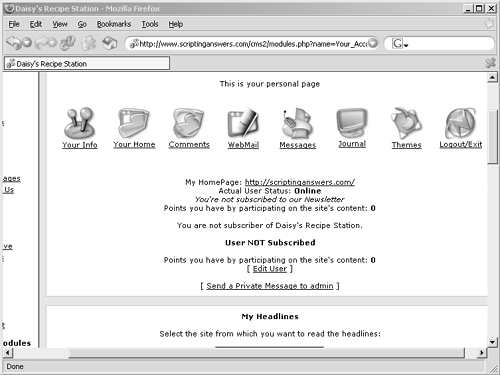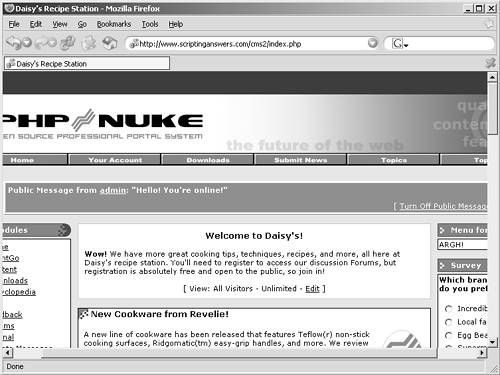| The Your Account module is perhaps one of the most critical modules in all of PHP-Nuke. Figure 31.1 shows the Your Account module as a user sees it after clicking Your Account in your site's Modules block (which serves as a main menu). Figure 31.1. The Your Account module's home page. 
The actual appearance of the module differs on your site; for one thing, themes can apply different graphics than the ones shown here, which are part of the default DeepBlue theme. Also, disabling features removes buttons. For example, if you disable the Private Messages module, the Messages button goes away from the Your Account screen. Here's what the various buttons allow users to do: Your Info. This page allows users to enter their name, contact information, instant messaging addresses, and other personal information. If entered, this information can be accessed by most site visitors, but entering the information is completely optional. Users can also configure a variety of options, such as whether they receive a newsletter from your site (the default is to not receive one), whether they are notified of replies in the Forums, and other options. Users can also change their login password on this page and configure their avatar. An avatar is a small graphic logo that represents a user, appearing next to that user's posts in the Forums. Users can upload a photo of themselves, for example, or select one of the many cartoon graphics included with PHP-Nuke. Your Home. This page allows users to configure some options for the home page. Users can select an alternate number of news stories for the front page rather than the site default (usually 10). Users can also activate a personal menu, which is a block that appears, by default, in the top of the right column. This personal menu can contain any text the user likes, including HTML formatting. Users can create HTML-formatted links to create a menu of hyperlinks to other Web sites or to specific pages within your site. Figure 31.2 shows an example personal menu, which simply says "ARGH!" Figure 31.2. Each user can have a personal menu on your site. 
Comments. This page allows users to configure how comments appear to them on your site. They can select a display mode, and hide anonymous comments or comments with low ratings. Users can also configure long comments to be abbreviated, requiring them to click a Read More link to see the entire comment and allowing more comments to fit on a single Web page. Webmail. The Webmail module has actually been discontinued in newer versions of PHP-Nuke, although older versions upgraded to a newer version still have it. Essentially, the module provides a Web e-mail reader. The module is considered defunct; you can disable it, if it's present on your site, in your site's preferences. Messages. This button provides a link to the Private Messages module, which I covered in Topic 20, "Using the Private Messages Module." Journal. This button provides a link to the Journal module, which I covered in Topic 17, "Using the Journal Module." Themes. This button allows users to select their own theme for your site from the list of themes installed on your Web server. Note that this functionality can be disabled, something I cover in the next topic. One danger in allowing users to select their own themes is that your site might be tweaked to work perfectly with one theme but won't look so hot with others. I recommend either disabling users' ability to select alternate themes for themselves or deleting any themes that make your site look particularly unattractive, leaving only the themes you consider to be viable alternatives to the site's main default theme. Logout/Exit. Pretty self-explanatory, this logs the user off your site. To access any modules that require site registration, the user has to log back in again.
The main page of the Your Account module also provides other user information, such as the number of points the user has earned by participating in your site (a concept I cover in Topic 46, "Administering Users and Admins"). There's also a personal headlines reader: Users can select from several predefined RSS newsfeeds and see their headlines. Or, users can type an RSS newsfeed URL and see the headlines. If you've enabled broadcast messages in your site's preferences, users can send a broadcast message, which is displayed to all site users for 10 minutes, and can see the number of private messages they have waiting. Broadcast messages, by the way, are displayed in a rather hard-to-miss fashion, as shown in Figure 31.3. The exact display is theme dependent (and some themes don't include the capability), but in general, you've got the message displayed in a bright red box at the top of the screen. You can disable broadcast messages for your entire site, and individual users can also turn them off using the link at the bottom of the message. Each user sees a broadcast message only once: Subsequent visits to the home page, even within the 10-minute period that the broadcast is "alive," don't display the message again. Figure 31.3. Public, or broadcast messages, appear at the top of the home page. 
|


